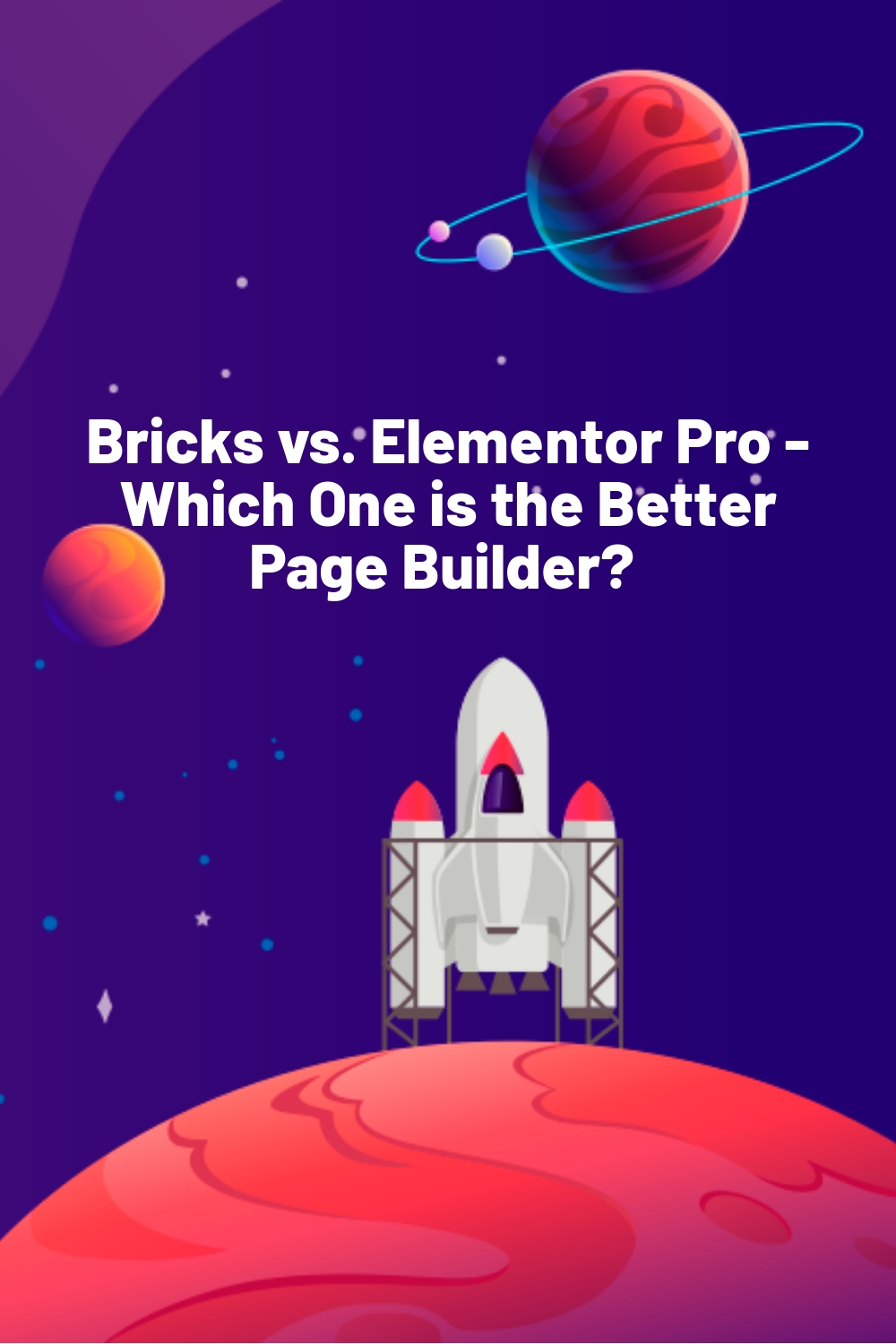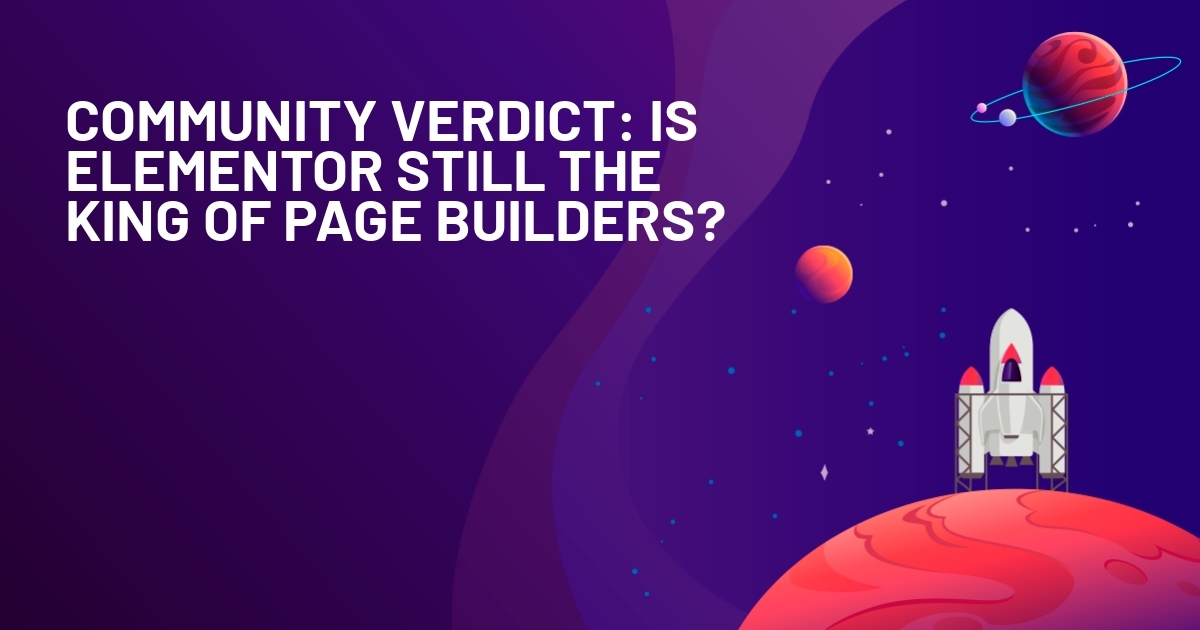WPLift is supported by its audience. When you purchase through links on our site, we may earn an affiliate commission.
Bricks vs. Elementor Pro – Which One is the Better Page Builder?

Bricks and Elementor Pro are two of the most popular WordPress page builder tools around, but which is the best option for creating your new website?
In this comprehensive guide, we’ll help you answer that question by putting the two platforms against one another in a head-to-head contest, comparing them both according to all the things that matter when choosing a page builder:
- Price
- User-friendliness
- Features and Add-Ons
- Theme and layout options
- Affect on website performance.
Bricks vs. Elementor Pro: Key Differences
| Elementor Pro | Bricks Builder | |
| Best suited for | Beginner and intermediate-level WordPress users | Advanced WordPress users and developers |
| Pricing | Lower entry-level pricing but requires a yearly subscription | Higher upfront cost but only requires a one-time payment for a lifetime license |
| Templates | A higher number of templates, though not all are high quality. | Smaller template library, though templates are generally of a higher quality than some of Elementor’s options. |
| Refund policy | 30-day money-back guarantee | “No pressure” refund policy means you can get your money back anytime. |
Why We’re Comparing Elementor Pro and Bricks Builder
For the longest time, Elementor Pro enjoyed an enviable reputation as the undisputed king of WordPress page builders, boasting some 8.8+ million active users.
As you’ll read in our complete 2023 Elementor review, the platform’s popularity owed much to its versatility, attractive templates, and beginner-friendly interface, and it looked to remain ahead of the game in all three areas despite increasingly stiff competition from the likes of WPBakery.
Then, in 2021, along came Bricks, a brand new site builder plugin that quickly earned widespread acclaim across the WordPress community thanks to its fast performance, attractive lifetime price plans, and features that are at least comparable to Elementor’s.
That’s the reason why we’ve created this guide.
It may be that you’re an existing Elementor Pro user thinking of making the switch after getting swept up in the Bricks Builder hype.
Or, perhaps you’re a brand new user still trying to find the perfect page builder to create your first WordPress site.
Whatever the case may be, the following head-to-head comparison will help you determine which tool is right for you.
Elementor Pro vs. Bricks Builder: Head-to-Head Comparison
1. Pricing
The first thing you need to know is that, of the two, Elementor is the only drag-and-drop builder that offers a free plan.

However, since that free plan is fairly limited, and Bricks doesn’t offer any free options at all, the fairest way to compare the two like-for-like is to stack Bricks up against Elementor Pro, the paid version of the plugin.
At first glance, Brick Builder may seem to be the more expensive of the two as its entry-level Starter plan costs $99 compared to just $59 for Elementor’s Essential Plan.
Look a little closer, however, and you’ll notice a significant difference:
Bricks’ plans come with a lifetime license, whereas Elementor Pro charges on a yearly basis.

This means that while Elementor Pro may initially cost less in the short term, you’re going to have to renew that $59 fee every year.
Go with Bricks, on the other hand, and after you shell out $99, it’s yours for life, and you’ll never have to invest another penny, making it a better deal in the long run.
Other Available Plans
Both – the Bricks Starter plan and the Elementor Pro Essential plan – only provide a license for one website.
If you plan to build more than one website, you could choose to make a $249 one-time payment for a lifetime license to Bricks or opt for one of the following yearly plans on Elementor.
- $99 p/y – 3 websites
- $199 p/y – 25 websites
- $399 p/y – 1,000 websites.
Money-Back Guarantee
Of the two, Bricks Builder seems to offer the better money-back guarantee. The company’s “no pressure” refund policy means that if you’re unhappy with your plan at any time, you can simply get in touch, and get your money back, no matter how long it’s been since your purchase.
On the other hand, Elementor Pro offers a standard 30-day money-back guarantee.
That said, Bricks notes that their “no pressure” policy won’t be around forever, so it’s always worth checking the terms of your plan before you make a purchase in case things change before we update this article.
The Verdict
Elementor Pro’s lower up-front pricing makes it a better deal for budget-restricted website owners looking to start a new site for as little money as possible.
However, given that you most likely want your website to stick around for years, we feel Brick Builder’s one-time lifetime license payment makes it a much better long-term option.
2. User-Friendliness
Here, we find a rare instance in which having more experience may actually be a disadvantage.
What we mean by this is that if you’re already familiar with Elementor, but you’re now thinking of switching to the Bricks Builder plugin, you may find yourself with something of a learning curve on your hands as the two platforms function somewhat differently.
However, if this is your first time using a page builder of any kind, you’ll find Bricks incredibly easy to get used to.

Once installed and activated, your first task with Bricks is to head over to the settings, and choose the content types you want to edit with it.
Our test site only contains posts and pages, but you can also use Bricks Builder with WooCommerce store pages and custom post types.
If you already have existing pages set up using the Gutenberg editor, you can also choose to convert them into Bricks.

Next, go to Pages – Add New and click Edit With Bricks. to access the Bricks editor.

You can then choose a template, and choose whether or not to import its existing style options and content.

Your new template then opens up in the three-columned page editor, which, on first appearance, feels a little crowded.

The biggest bugbear here is the structure menu on the right.
Sure, it’s helpful to have this feature as it makes it easy to jump around to different sections of your page.
However, it only collapses vertically and not horizontally, which basically means there’s no way to hide it altogether, leaving you with a much smaller canvas on which to edit your content.

Once you get into the editing process, you’ll find a wealth of options for every element.
In this example, editing our heading not only gives us basic options, such as the ability to change the text, the style of the text, and whether it features a link, but also separate tabs for conditional logic (making the element appear only when certain conditions are met) and interactions (for example, hiding or animating the element when clicked on.)
At first, it’s a lot to contend with.
Even as experienced WordPress users, we found the number of options crammed into every Brick editing menu to be somewhat overwhelming.

This is especially true when you consider some options, such as the HTML tag options above, or the ability to use different images at different breakpoints to improve the usability of your responsive theme, may be completely unfamiliar to beginners.
Fortunately, Brick doesn’t take long to get used to and, for the most part, proves itself to be quite an intuitive platform.
Still, you don’t have to spend long time with it to get the distinct impression that this is a page builder designed for more serious, advanced website creators rather than first-time novices.

With Elementor, not only is the page editor much less cluttered, but it also takes no time to get to grips with.
After selecting a new page, and clicking Edit With Elementor, your first task is to click Add Template.

You can choose from a vast library of page templates, or create your layout using attractive, pre-designed content blocks.

Once you’ve chosen your design, you can click on existing elements, or drag them into place from the main element menu, just as you can with Bricks.
As you can see in the example above, the editing menu for these elements doesn’t cram in as many features, but it results in a much cleaner, easier-to-use interface while still packing in all the essentials.
The Verdict
From a usability standpoint, both page builders are very good. Elementor is certainly the more intuitive of the two and a good choice for beginners, while the abundance of options featured in every element makes it a better choice for those with more experience. ‘
3. Template Libraries
When choosing the right template for your website, quality and quantity matter in equal measure.
After all, while having an extensive library of template options to choose from means you’re more likely to find one that best suits your needs, that’s no help if your template doesn’t look good or function correctly on all devices.
All that makes this round a particularly tough one to call.

In terms of quantity, Elementor Pro wins hands down. The page builder tool offers a broader selection of templates, with over 300 templates covering a wide range of industries and niches, including business, eCommerce, portfolio, and blogs.
However, while some of these templates are designed to a very high standard, others are quite basic, and typically require extensive customization

On the other hand, Bricks offers a smaller selection of templates, with around 200 modern templates to choose from, many of which surpass the quality of those Elementor offers.
The Verdict:
Ultimately, we have to give the win to Bricks Builder, whose library of templates is very well-designed to suit the needs of contemporary audiences. Sure, Elementor has a larger library, but that has at least a little to do with the fact that the platform had a five-year head start on its rival.
Give Bricks Builder more time, and we’re sure we’ll see it also outperform Elementor Pro in terms of quantity.
4. Features and Add-Ons
Out of the box, both Elementor Pro and Bricks Builder contain all the standard features you’d want when crafting your web pages.
Text, images, headings, links, and buttons are all present and correct, as are all the following:
- Advanced page-building elements – Such as galleries, sliders, forms, and social media integrations
- Style option – Including control over fonts, colors, borders, and the ability to set custom padding and margins around your elements.
- Layout options – columns, rows, and sections to structure your pages.

When it comes to add-ons and extensions, Elementor Pro’s longevity once again works in its favor.

The truth is there are more Elementor Pro add-ons than Bricks Builder add-ons, though this may be because Elementor Pro has been around for longer, and has a larger community of developers. However, Bricks Builder is still under development, and new add-ons are being released regularly.
Both platforms contain a range of free and premium add-ons that allow further customizations and functionality, including tools specifically designed to create forms, build eCommerce stores, and add interactive elements such as live chat support.
The Verdict:
After much deliberation, we’re declaring this round a draw.
Elementor Pro and Bricks Builder are evenly matched when it comes to out-of-the-box features. Though you’ll find far more add-ons for Elementor Pro than Bricks, we wouldn’t be surprised to see the latter catching up in time.
5. Support Options
Both platforms score high marks in terms of user support.
Whether you use Bricks or Elementor Pro, you’ll have access to a sizable knowledge base with guides, tutorials, and walk-throughs showing you how to do everything from building your first pages to troubleshooting common problems.
Given what we’ve been learning in this review about Bricks’ intended audience, it probably shouldn’t be surprising that Elementor Pro’s knowledge base is more accessible and beginner-friendly than Bricks, though not by a great deal.
Elsewhere, both platforms are also supported by a growing community support forum and get help from other users and developers.
In terms of actual, direct support, Elementor Pro and Bricks Builder both provide that in the form of an email ticketing system.
Having put both to the test, we can confirm that each page builder’s support team is as efficient and helpful as the other, responding to our questions within the space of a few hours, and solving our problems at the first point of contact.
The Verdict
Both page builders are very evenly matched when it comes to technical support, boasting very active communities full of helpful users and knowledgeable, responsive support teams.
No matter which platform you decide to use, you’ll be well taken care of should you run into any problems.
Frequently Asked Questions
Does Bricks Builder offer a free trial?
Unfortunately, Bricks Builder does not offer a free trial. However, you can test out all of its features using their Bricks Playground test site, which you can access for free after entering a username and password.
Which page builder offers the best AI features? Elementor Pro or Bricks Builder?
Both tools include some AI features, though Elementor Pro is currently ahead of the curve in this regard.
The widely-used page builder includes features that use artificial intelligence to automatically generate text, post titles, images, and even code for your pages and templates, as well as an AI design assistant.
So far, Brick Builder offers none of these features in its core product, though some limited AI capability can be found in the various add-ons available.
Which is faster – Elementor Pro or Bricks Builder?
As a newer product designed with performance in mind, Bricks Builder is primarily considered to be faster than Elementor Pro, which has something of a reputation for its negative effect on WordPress site performance.
Elementor Pro vs. Brick Builder: Which is The Best Page Builder to Use?
By now, you’ve seen how Elementor Pro and Bricks Builder compare in terms of essential factors such as template quality, ease of use, and cost.
Hopefully, our deep dive into these factors has helped you determine which of the two-page builders is best for you and your website.
If not, let’s finish things up with a final recommendation.
If you’re new to WordPress and the very process of building websites, you’ll find that Elementor Pro’s highly intuitive drag-and-drop interface and extensive library of templates work better for you than Brick Builder, which includes an interface that often feels cramped and overcrowded.
However, if you’re an experienced user or perhaps even a WordPress developer looking to cut down on the time it takes to create high-grade, professional-quality sites for your clients, Bricks Builder may have more appeal.
The platform’s advanced controls and features put you firmly in the driver’s seat, giving you maximum freedom to create dynamic, fully responsive, and feature-rich sites.
What’s more, although Bricks doesn’t contain as many templates as Elementor, this is hardly likely to be much of a problem for WordPress pros as you’ll be armed with all the tools needed to create great-looking templates from scratch.
And, if neither one quite works for you? Don’t worry. We’ve got you covered there too!
Check out our guide to the 9 best page builder plugins to explore even more alternatives.








